Karen Davis's segment on Viva from REAL HEALTH Podcast 84
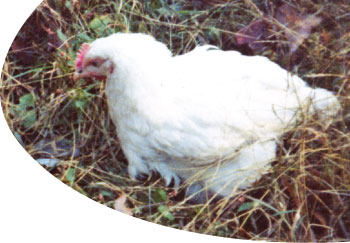
By Karen Davis, PhD, President & Founder of United Poultry Concerns
Buried in the trees behind the fence at the back of our yard, there was a chicken house which opened onto the cow pasture on the other side. It belonged to our landlady. When we first rented the place, I used to pass by it regularly on my way to the pond at the bottom of the pasture slope. A ramshackle structure made of wood with a door latch tied shut with a string, the chicken house sat low on the pasture side under the sky, surrounded by broken pieces of old farm equipment scattered and piled every which way. Approached from the overgrown garden path, it rested among flickering shadows of yellow and green leaves, with shafts of sunlight and small breezes filtering through. When we first moved in it was empty, and I, a lifelong suburbanite, gave scarce thought to what manner of life it had housed before our coming. Peering through the dusky screen at the garden end, I could see a compacted dirt floor with a large metal cylinder in the middle, and over at the far end, a low shelf crammed to the roof with junk. Stray wisps of white feathers lay about, some lifted up by the breeze.
One July day on my way to the pond I stopped short. Through the leaves, I thought I saw white forms moving around on the other side of the screen. Listening, I thought I heard voices. A moment later I was staring through the screen. White, young-looking chickens covered the ground. Several, when they saw me, came over and sank down in front of me. Back then I knew almost nothing about chickens, but I could see that their legs weren’t right. They tended to be thick and swollen with the toes curling inward and outward in odd sorts of ways. Many could barely make their way to the metal feeder which stood at a considerable distance, under the circumstances, from the water trough rigged up along one wall. A few fumbling steps and they would sink down on their broad, heavy breasts, their eyes peering at me.
From then on I used to visit the chickens almost every day, wondering dimly as to their ultimate fate. One morning in late August I went out to see them as usual. Only, this time the place was deserted. Then I saw her.
She was stumbling around over by the feed cylinder on the far side where the low shelf piled with junk made everything dark. A shaft of sunlight had caught her, but by the time I was able to get inside she had scrunched herself deep in the far corner underneath the shelf against the wall. She shrank as I reached in to gather her up and lift her out of there. I held her in my lap stroking her feathers and looked at her. She was small and looked as if she had never been in the sun. Her feathers and legs and beak were brownstained with dirt and feces and dust. Her eyes were as lusterless as the rest of her, and her feet and legs were deformed. I let her go and she hobbled back to the corner where she must have spent the summer, coming out only to eat and drink. She had managed to escape being trampled to death, unlike the chicken I had found some weeks earlier stretched out and pounded into the dirt.
I made her a bed by the stove, close to our kitchen table. We named her Viva. Neurotically adapted to corners by now, Viva would hide her head in whatever closest corner she could find inside the house, or if outside she would often stick her head under a bush or pile of cut grass and just stay that way. Despite this, she liked to be outdoors. To see her sitting among the bright leaves scattered over the grass in the autumn sunshine, you would not have guessed what her legs and feet were like. Yet she liked to move around. When we first had her she used to cover a surprisingly wide territory in spite of her hardship, for though crippled, she was quick, and I would sometimes catch her hobbling vigorously to some point or other straight across the yard with her little wings fluttering.
She used her wings for balance in order to get about. To steady herself, and to keep from falling, she would spread them out so that the feather ends touched the ground, and standing thus, she would totter from side to side in a painstaking adjustment before going ahead. Much of her energy was spent upon this procedure every other step or so.
At first I hoped that exercise would help strengthen her legs, but as her body grew bigger they got worse. Often I would find her sitting with them spread out on either side of her, and sometimes they would even get caught in her wings, causing her terrible confusion and distress. One day I noticed that certain parts of her legs and feet were a greenish-blue, and wondered if she had some disease. I’d been thinking lately that even if she were not in actual physical pain, which I wasn’t sure of, she was still in some kind of acute misery, for she acted as though she was. She hid her face in corners more and more as the weeks went by, and ordinary efforts like eating and turning around were increasingly done with a commotion which left her exhausted.
One of the most touching things about Viva was her voice. She would always talk to me with her frail “peep peep” which never got any louder and seemed to come from somewhere in the center of her body which pulsed her tail at precisely the same time. Also, rarely, she gave a little trill. Often after one of her ordeals, I would sit talking to her, stroking her beautiful back and her feet that were so soft between the toes and on the bottoms, and she would carry on the dialogue with me, her tail feathers twitching in a kind of unison with each of her utterances.
I decided to have her looked at, so I made an appointment and on a Saturday morning took her in a bed of straw in a cardboard box to the veterinarian’s office an hour away.
The veterinarian asked briskly, was this some sort of pet, what was it? No, I said, not exactly – Viva was our companion, she had been abandoned and she lived with us in our house. The veterinarian looked at me. She said, “Most people would not care what happened to a chicken.”
She spread out Viva’s wings and showed me that the undersides were black and blue like the blotches in her legs and feet. She said that because of her struggle with her condition, Viva’s body was full of wounds, inside as well as out. I asked, what is her condition? And she said Viva suffered from a congenital leg defect, called splay foot, an inborn weakness in her joints typical of birds bred for the modern food industry. She said Viva should be euthanized and that she would use an inhalant, which is more gentle than the usual leg injection. She had to look in on another animal just now which would give me time to spend a last few minutes alone with my friend.
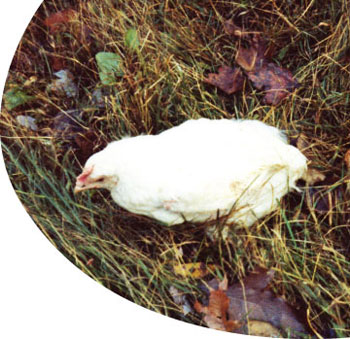
I pulled up a chair next to the box on the table with Viva in it. Just then a young veterinary aid rushed in, “Where is it? Can I see it? I’ve never seen a chicken,” she said making for the table. She left. I thought my heart would burst. Viva was very peaceful, and when I spoke to her she piped back in the way that she had, her little tail pulsing its perky beats, from somewhere inside.
The veterinarian took Viva away. Later, as I was leaving, she said that Viva would not die fast enough so she had to use a leg injection after all. She thanked me for caring about a chicken. I placed Viva in the car on the front seat beside me. The box in which she had travelled alive she was carried home dead in. My husband and I dug a hole in the corner of the yard and laid her inside. We covered her up with the dirt. I made a note on the inside cover of my dictionary: On Saturday, November 28, 1985, soft Viva died.
“Viva, The Chicken Hen, June-November 1985,” by Karen Davis, PhD, was originally published in Between The Species: A Journal of Ethics, Winter 1990. Karen Davis is the President and Founder of United Poultry Concerns.
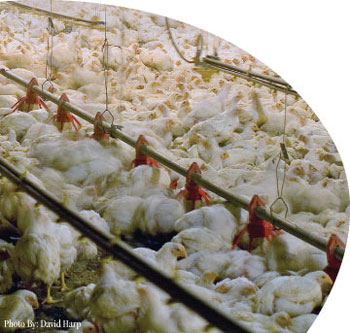
Chickens are cheerful, vibrant, sociable birds who evolved in the forests of India and Southeast Asia. Chickens mass-produced for food never feel the sun or soft grass or see the sky overhead. They never know the comfort of a mother hen’s wing or the pleasure of parenting their young. Every day in North America and throughout the world, hundreds of millions of chickens are forced to live in filth and fear and are brutally slaughtered. As a result of genetic manipulation for overgrown muscle tissue of the breast and thighs, chickens suffer miserably from painful lameness. They suffer from gastrointestinal disorders, blood diseases, and chronic respiratory infections. The parents of these birds are kept in darkness on semi-starvation diets designed to reduce the mating infirmities that result from breeding chickens to grow too large too fast.
During their six weeks of life, “broiler” chickens – soft young chickens just like Viva – live in semi-darkness on manure-drenched wood shavings, unchanged through several flocks of 30,000 to 50,000 or more birds in a single shed. The ammonia causes chickens to develop a blinding eye disease called ammonia burn. So painful is this disease that afflicted birds rub their hurting eyes with their wings and let out cries of pain.
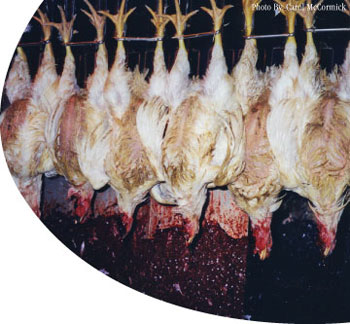
“Broiler” chickens are crowded by the thousands in long dark sheds contaminated with Salmonella, Listeria and Campylobacter bacteria and Avian Influenza viruses. Poultry products are the main source of food poisoning in the home and a leading cause of arthritis in consumers.
Catching, Transport, and Slaughter
At six to twelve weeks old, chickens are violently cornered and grabbed by catching crews and carried upside down by their legs – struggling, flapping, and crying – to the transport truck.
At the slaughterhouse, the chickens are torn from the cages and hung upside down on a conveyer belt. As they move toward the killing knife, they are dragged through an electrical current that paralyzes their muscles but Does Not Stun Them. Chickens are intentionally kept alive through the slaughter process so their hearts will continue to beat and pump out blood.
“The chickens hang there and look at you while they are bleeding. They try to hide their head from you by sticking it under the wing of the chicken next to them on the slaughter line. You can tell by them looking at you, they’re scared to death.” – Virgil Butler, former Tyson chicken slaughterhouse worker in Grannis, Arkansas.
Millions of chickens are alive, conscious and breathing not only as their throats are being cut but afterwards, when they are plunged into scalding water to remove their feathers. In the scalder, “the chickens scream, kick, and their eyeballs pop out of their heads,” said Virgil Butler. The industry calls these birds “redskins” – birds who were scalded while they were still alive.
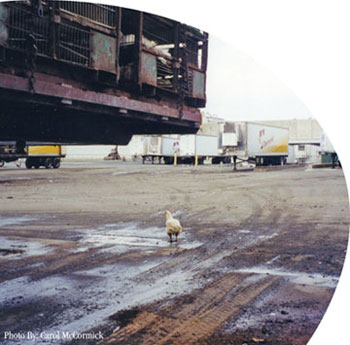
Please Do a Compassionate Deed for Chickens & a Kinder and More Gentle World. Go Vegan.
For more information about chickens and
how you can help them, contact
United Poultry Concerns
A nonprofit organization dedicated to the compassionate and respectful treatment of chickens, turkeys, ducks and other domestic fowl.
